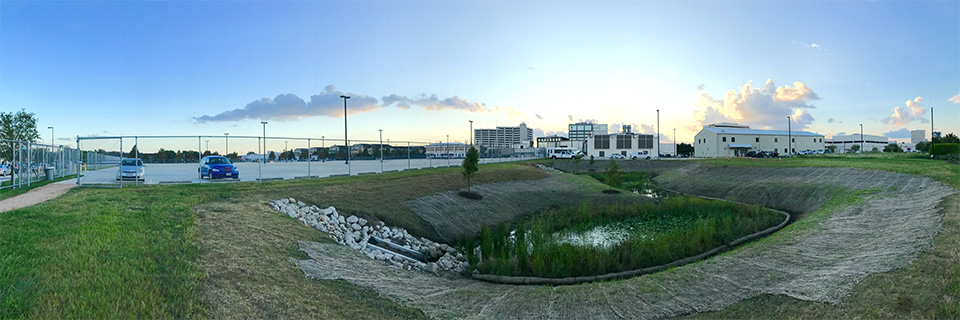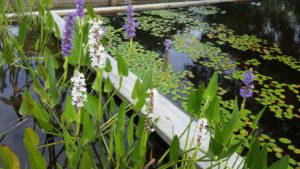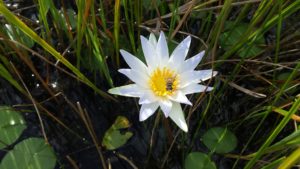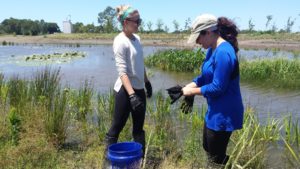
A new stormwater wetland demonstration site on the campus of the MD Anderson Cancer Center cleanses runoff from the adjacent parking lot as it makes its way to Brays Bayou. Photo: Harwood Taylor
TCWP is demonstrating the benefits of designing wetlands into an essential part of our drainage infrastructure: flood control basins. The Stormwater Wetland Program provides on-the-ground demonstration projects, applied research, and education to increase awareness of this stormwater management practice.
Too often, a standard detention basin provides little in the way of water quality improvement and habitat. However, stormwater detention basins that incorporate stormwater wetlands can provide a multiplicity of benefits:
Water Quality Improvements
Through biochemical and physical processes, plants and associated biofilms (populations of microbes, algae, and cyanobacteria) in wetlands reduce levels of fecal bacteria, metals, nitrogen and phosphorus, and sediment that are characteristic of urban, suburban, and roadway stormwater runoff. The unique bio-geochemistry of wetlands transforms pollutants into less harmful forms. For example, in wetlands, nitrates from fertilizer carried by stormwater runoff are transformed into harmless nitrogen gas. Many pathogens are also removed by microbial predation as well as solar disinfection. Sediments are filtered out of water by the plants themselves. Stormwater is gradually released from the basin through an engineered outfall structure into local waterways, improving downstream water quality. Stormwater wetlands are generally designed to detain a high percentage of storms; in the Galveston Bay area, 92% of all rain events are 2” or less. Stormwater captured and treated by the wetland is released through a weir in an outfall structure over a calculated period, often 48-96 hours.

These nursery plants will be transplanted to a demonstration site where their stems, roots, and leaf surfaces will remove a variety of contaminants in stormwater.
Wildlife Benefits
Restored and created wetlands can provide critically needed habitat. Up to half of all North American bird species nest or feed in wetlands [EPA 843-F-06-004], and simultaneously the Gulf coastal prairies and wetlands are one of the most threatened natural habitats [USFWS Pub: Paradise Lost 1999] . More than 30% of North American bird populations are in “significant decline” according to the National Audubon Society. Downstream, the health of submerged aquatic vegetation in estuaries, important breeding and nursery grounds for fish and shellfish species, is impacted by high levels of sediment and nutrients, typical of stormwater runoff from developed areas.
Better Recreation
Habitat enrichment provided by a stormwater basin containing wetlands also attracts people for birdwatching, walking, and other recreation. Downstream in the bays and the Gulf, the primary cause of beach closures is high levels of fecal bacteria in untreated stormwater runoff [www.epa.gov/beach-tech].
Visit our demonstration sites
See our wetland nurseries
Read up on our activities
Plants for Texas Gulf Coast stormwater wetlands
Stormwater Wetland Monitoring Project
Stormwater Treatment Wetland Design
The Stormwater Wetland Program has been supported by the Texas General Land Office, Coastal Management Program, Galveston Bay Estuary Program, Texas Commission on Environmental Quality, Texas Sea Grant, National Oceanic and Atmospheric Administration, Renewable Resources Extension Act Program, the Clear Lake City Water Authority, and others.
 Texas Community Watershed Partners
Texas Community Watershed Partners 

